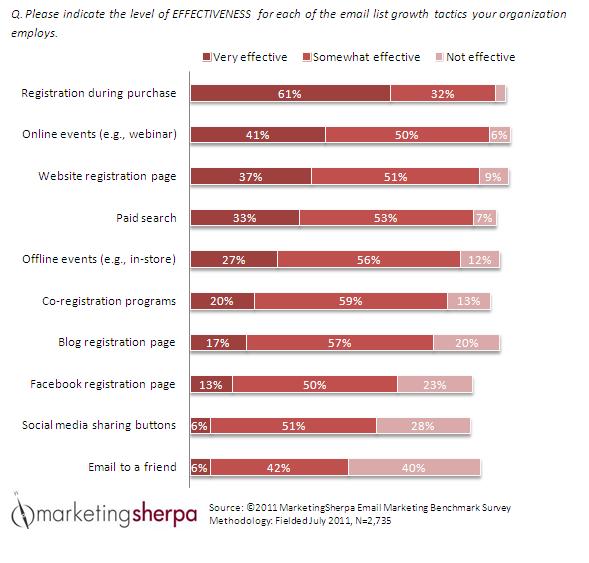Email Research: Top 3 tactics to grow your list
Growing your email list has benefits beyond the obvious increase in size. For example, new subscribers are often more active than older ones. They just signed up for your emails and want to click and open them.
For this reason (and many others) you should always strive to grow your email list. Doing so will help keep your engagement numbers healthy and ensure your brand is connecting with new prospects.
Growing your database can seem daunting, though, with the number of tactics at your disposal. Thankfully, marketers have been running list growth campaigns for years. Here is a chart of 10 popular tactics, starting with the most effective on top. The chart is pulled from the all new MarketingSherpa 2012 Email Marketing Benchmark Report.
The Most Effective Tactic: Registration during purchase
More than 90% of email marketers say adding an opt-in request to the purchase process is at least “somewhat effective” at growing email lists. This tactic is also the only one to have more than half of email marketers (61%) saying it is “very effective.”
Digging deeper in the Benchmark Report, we find this tactic was only the sixth-most used among the 10 listed. The tactic is vastly more popular among e-commerce marketers (59% use it) compared to marketers in other industries:
- Professional or financial services: 31%
- Software and software as a service: 28%
- Education or healthcare: 26%
Most Effective Tactic #2: Online events (webinars, etc.)
Offering content or something else of value is a common way to build an email list. We’re seeing online events prove to be effective incentives. More than 90% of email marketers say they are at least “somewhat effective” at building lists and 41% say they are “very effective.”
Online events appear to work best in the software sector, with 46% of email marketers there saying the tactic is “very effective.” That number drops to only 24% in the e-commerce sector, which is understandable. When was the last time you attended an event to buy something on Amazon?
Most Effective Tactic #3: Website registration page
Website registration pages are, far-and-away, the most popular tactic for growing email lists, with 75% of email marketers using them. Their popularity remains above 70% across email marketers who target consumers, businesses or a mix of both.
Adding several calls-to-action to join your list throughout your website is an effective tactic, and you can greatly improve results by following best practices. Kodak, for example, captured 33% more email subscribers by updating its email capture form, adding more opt-in requests, and adding a capture form to Facebook. (The team overhauled its welcome emails, and added social subscribers, too.)
Related Resources:
MarketingSherpa 2012 Email Marketing Benchmark Report
Email List Growth: Finding low-cost and no-cost ways to grow your database
Email Research: The 5 best email variables to test
Email Marketing: How to sprinkle subscribers with a well-timed welcome in 5 steps
MarketingSherpa Email Summit 2012
–
Categories: Email Marketing











This information is pretty consistent with what we’ve discovered at Digett while working to grow our own list. Most of our new subscribers come from landing pages: they fill out a form to get a whitepaper, and sign up for the newsletter in the process.
I wonder about what is meant specifically by “Offline events,” in the first graph. Does this mean that the store’s putting up a sign at the register or on the front door encouraging people to sign up, or are they asking on an individual basis: “Thanks for your purchases, would you like me to sign you up for the newsletter?” I shop at places all the time that ask for my email address when I check out, and I generally end up on a newsletter even though I haven’t actually given them permission to email me.
Hi Adam: Wondering who I can speak with about getting permission to use a high-res version of that chart above. Can you connect me with someone?
@DJ Waldow Hi DJ. You’re welcome to use the chart as long as you attribute it to its source, MarketingSherpa’s 2012 Email Marketing Benchmark Report at http://www.meclabs.com/training/publications/benchmark-report/2012-email-marketing
Great blog!!
From an eCommerce perspective, the easiest way we have found to grow our database (and reduce the number of opt-outs) is to offer an incentive for people to subscribe/sign-up to our email marketing.
We’ve found much success collecting emails at our fundraiser and events using just a few ipads for our volunteers to use. here’s the app we used: http://www.threadcommerce.com/
We also found that sending folks an email at least 24 hours after the event with a call to action resulted in a donation or followup by a higher percentage that someone who signed up to our website.